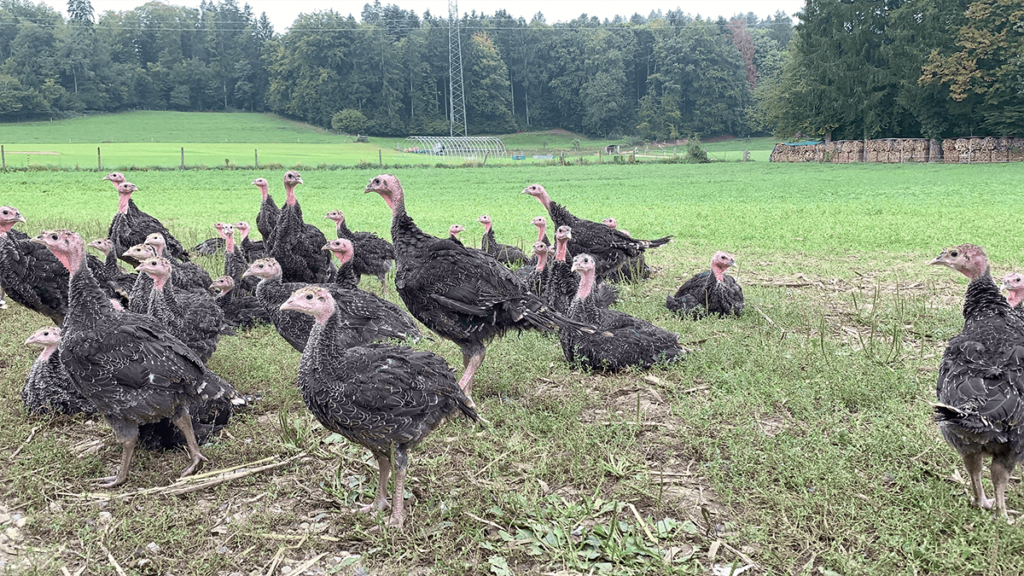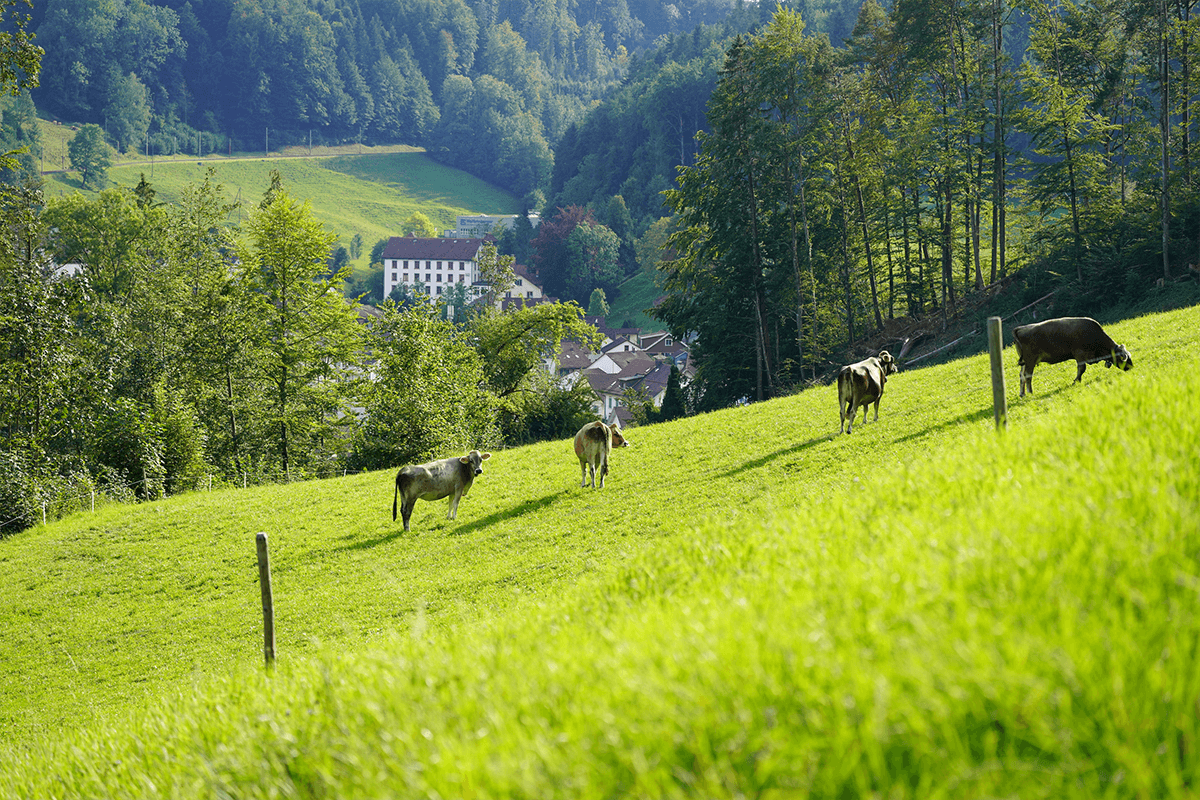“Actually, it’s quite simple — I just wonder how I would like it in terms of freedom.” Esther Vock from Wendelinhof on animal husbandry
Fresh eggs for scrambled eggs for the morning, cervelats for the night: When looking for these ingredients, you’ve probably come across terms such as “organic farming”, “free range farming”, “stable farming”, “barn farming” among others while shopping. These indicate the type of husbandry of the respective animal, providing information about its living conditions and well-being.
But what’s the difference?
In general, barn farming (or stable farming) is the most cost-effective form of animal husbandry, the minimum requirements of which are laid down in the Swiss Ordinance on Animal Welfare. In contrast, free range farming (or grazing) offers farm animals a living environment that better meets their natural needs than barn farming.
This is where the federal support programmes, which should motivate people to go beyond the legal minimum in animal welfare, come into play: While BTS stands for “besonders tierfreundliche Stallhaltung” (particularly animal-friendly housing), RAUS stands for “regelmässigen Auslauf im Freien” (regular outdoor exercise). Provided these programmes are fulfilled by the animal owners, they are rewarded with financial contributions. The provisions of these programmes are intended to guarantee the animals living conditions as appropriate to their species as possible so that they can meet their natural needs as closely as possible.
But what exactly does animal husbandry in Switzerland look like? This will be illustrated below using three animal species.
Pig Farming
Pigs are among the most intelligent animals and are known for their extremely sociable and curious nature. Therefore they like to stay in larger groups and prefer to explore their surroundings. Despite this, most fattening pigs in Switzerland are kept in stables, where only 0.9m² of space per animal is required by law. And in most cases they will never be able to put their hooves outside. So it is not surprising that these living conditions often lead to behavioural disorders in pigs. Only in free range farming, which offers them more space and daily, species-appropriate exercise, can pigs fulfil their natural needs: wallowing in mud, digging in the ground and eating. To achieve this, the “outdoor” rules for pigs require several hours a day of outdoor grazing or roaming and permanent access to a resting area. In addition, BTS requires pig farmers to sprinkle the resting area with long straw or Chinese reed and to equip it with a light source of at least 15 lux.
Cattle Farming
For cattle which, under natural conditions, are mainly busy grazing and cover several kilometres a day, a distinction is made between stable and pasture farming. The former, however, offers these 500 kilogram animals only three square metres of barn space which leaves them hardly any room to move. By contrast, cattle in stables that comply with BTS regulations are given more than twice as much space. That being said, cattle kept indoors will probably never enjoy the sun and fresh air, which means that a key component of animal welfare is missing. The RAUS programme requires cattle farmers at this point to provide at least 26 days per month of outdoor grazing or exercise in a pasture/exercise yard between May 1 and October 31.
Chicken Farming
In their natural habitat, chickens prefer to scratch the grass, peck grains, bathe in the sand and enjoy the sun. However, the everyday life of barn or coop hens looks a little different: Depending on the farming system, between 7 and 17 chickens per square metre may be kept here. Apart from these cramped conditions in the henhouse, there is no outdoor space available to the animals. This means their natural needs cannot be met. However, if the laying hen farmers take part in the BTS programme, the hens also have a winter garden at their disposal — a covered and bedded area in front of the chicken coop where they can go outside. On the other hand, free range hens must not only meet the BTS requirements, but must also be given daily free access to pasture, the rules for which are laid down in the RAUS programme. According to these rules, each free range laying hen is entitled to 2.5m² of grazing land. And although free range farming represents a significant improvement in keeping chickens, in many cases it is still associated with factory farming. In contrast, organic free range farming is considered to be the most strictly regulated of all farming methods and offers the animals the highest quality of life with at least 5 square metres of grazing space per chicken. They live on certified organic farms in small groups and feed on high-quality feed from organic farming. In addition, no more than 5 hens per square metre may live in an organic barn.
Free Range Husbandry on the Wendelinhof
To learn more about free range farming, we spoke to Esther Vock from Wendelinhof.

Your poultry are free range. What exactly does this and animal-friendly husbandry mean to you?
For us, animal-friendly husbandry means that the animals can fulfil their natural instincts: pecking, scratching, moving freely, having social relationships with each other. This also requires a lot of work — during fattening, our birds eat the grass away, meaning the coop has to be moved, so nothing can be permanently installed. In addition, we feed and do the bedding by hand as opposed to mechanically.
That sounds like a lot of work! What exactly does your daily routine look like?
In the morning we let the birds out to frolic at sunrise. I check that everything is in order in the barn: whether a fox or a marten was there at night, whether the animals are healthy, whether or not they are huddling on the floor. We then feed the animals, but only inside the barn — outside there is plenty of grass for them to eat. Then we sprinkle them with grass so that they have clean straw. My rule of thumb: It should always be clean enough that you can sprinkle with clean trainers! Only then is it really clean. And in the evening we close again. In the summer the days are especially long: we get up and start at 04:30 and close up at 22:00. This is, of course, accompanied by little sleep.
And how does it look in winter?
Then the procedure is exactly the same, only the days are shorter because there’s not as much light. Winter is when we have more work to do with our cows, because they live in the stables. That means more cleaning and feeding them more frequently. But our birds can go outside in winter so nothing changes for them.
Getting back to the topic of free range farming — your farm is certified KAGfreiland. What exactly does it require?
To do this, you first need to have the Bio Suisse Knospe. Then it’s a question of whether there is enough space for the animals, whether there is enough free enclosure outside and whether the stables are really larger than the normal ones from organic farming. In addition, the fattening sizes are smaller. For example, in the case of chicken, a maximum of 400 animals may be kept per fattening unit. At the same time, the individual animals must have a larger area available.
You do not use antibiotics. What happens if one of your animals falls ill?
The first step is to identify a sick animal by regular observation. We then treat it first with homeopathic globules or an oregano oil, which is good for digestion. But in fact, our birds rarely get sick: we haven’t had an issue for 12 years. The main reason for sick birds is that they are kept exclusively indoors where they use ammonia — we don’t use it at all. However, if a bird is really sick, we have the possibility to relieve it by means of emergency slaughter.
But to what extent is free range farming really better? Why should you choose meat and eggs from free range rather than barn farming?
I believe consumers should think about how they would like to live themselves. Would they prefer an air-raid shelter where they’re locked up with 2000 others? It stinks, you get aggressive, you start to bother and annoy each other… Or would you like to be able to go outside, to move where you want and to make enjoy social activities? It’s actually quite simple – I just wonder how I would like it in terms of freedom.
Organic Labels That Go One Step Further
Esther’s Wendelinhof is certified by KAGfreiland and Bio Suisse Knospe. These Swiss organic labels and certificates guarantee an even higher level of animal welfare than the farming methods presented so far. In general, they provide species-appropriate animal husbandry for all animal species – including exercise or grazing, the prohibition of (exclusively) slatted floors, cages and the preventive use of antibiotics.
- KAGfreiland is the strictest label in Switzerland – it is only awarded to farms that treat their animals in a truly species-appropriate manner. This also includes decentralised slaughtering and relieving the animals of painful transport routes. The guidelines for animal husbandry include daily exercise, natural organic feed without artificial additives and specific rules depending on the animal species.
- Demeter stands for biodynamic production and is among the strictest labels. This is done with the aim that the farm animals can behave in accordance with their nature. More precisely, a Demeter label guarantees that the animal has been kept according to its species. This meant that they had plenty of space and exercise, a longer life and fed exclusively on organic feed. In addition its beak and horns could not be shortened.
- The Bio Suisse Knospe guidelines focus on the development and preservation of nature and the environment. This means that animals are kept and fed in a particularly species-appropriate manner. This includes a diverse environment with regular exercise in all seasons and more space than in conventional animal husbandry. At the same time, they are allowed to enjoy a longer life than usual and are fed organic food that is appropriate to their species.
- Bio Knospe stands for sustainable economy, respectful treatment of animals and nature, renouncement of chemicals and strongly regulated additives and auxiliary materials. The same conditions as Bio Suisse Knospe apply to this label. The only difference: Bio Knospe products obtain more than 10 percent of their raw materials from abroad. This is why Suisse is missing from this Knospe.
At Farmy we make sure that the majority of our meat products are either organic, KAGfreiland or Demeter certified or come from Switzerland. There are no compromises when it comes to our meat – only the best and freshest cuts should reach our customers. That’s why our highest rules are as follows: Transparency, animal welfare and regional origin. Our conventional butcher’s shops, Heinzer and Metzgerei Keller are traditional companies with a good reputation, who value regionality and good quality. In addition, Heinzer still slaughters its own animals, which is now very rare.












What do you think?